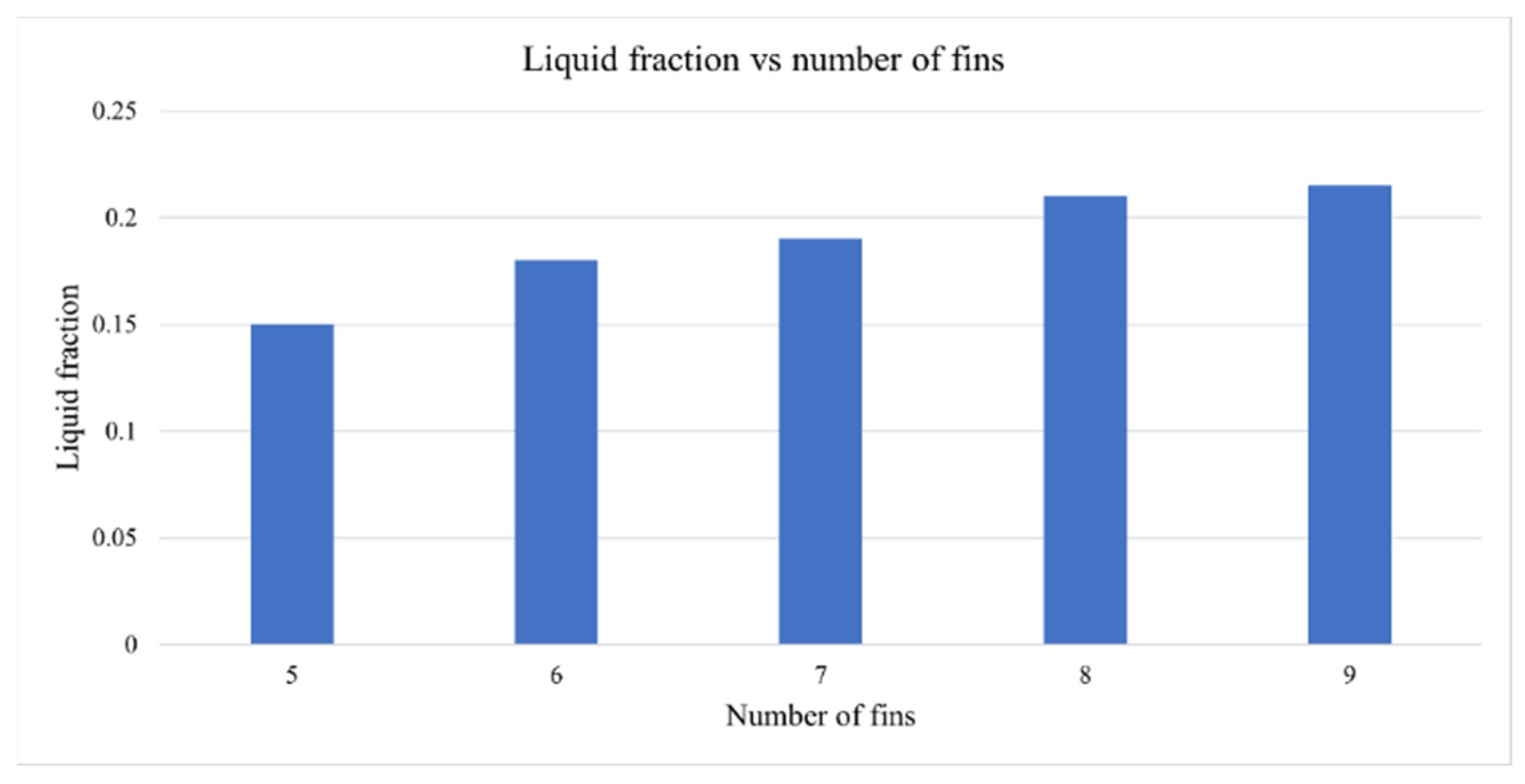Investigation of Optimal Aspect Ratio and Optimal Number of Fins for Thermal Performance of Finned-Concentric-Tube Thermal Energy Storage †
Abstract
:1. Introduction
2. Model Description
3. Results and Discussion
3.1. Effect of Aspect Ratio on TES Performance
3.2. Influence of Number of Fins on TES Performance
3.3. Comparison of Charging between Optimal Configuration and TES without Fins
4. Conclusions
Data Availability Statement
Conflicts of Interest
References
- Pardo, P.; Deydier, A.; Anxionnaz-Minvielle, Z.; Rougé, S.; Cabassud, M.; Cognet, P. A review on high temperature thermochemical heat energy storage. Renew. Sustain. Energy Rev. 2014, 32, 591–610. [Google Scholar] [CrossRef] [Green Version]
- Sarbu, I.; Sebarchievici, C. A Comprehensive Review of Thermal Energy Storage. Sustainability 2018, 10, 191. [Google Scholar] [CrossRef] [Green Version]
- De Gracia, A.; Cabeza, L.F. Phase change materials and thermal energy storage for buildings. Energy Build. 2015, 103, 414–419. [Google Scholar] [CrossRef] [Green Version]
- Mehling, H.; Cabeza, L.F. Heat and Cold Storage with PCM; Springer: Berlin/Heidelberg, Germany, 2008. [Google Scholar]
- Trp, A. An experimental and numerical investigation of heat transfer during technical grade paraffin melting and solidification in a shell-and-tube latent thermal energy storage unit. Sol. Energy 2005, 79, 648–660. [Google Scholar] [CrossRef]
- Rabbi, J.; Asif, M. A numerical study on effects of heat transfer fluids, copper mesh in packed bed and porosity, on charging time of paraffin based packed bed thermal energy storage. Energy Storage 2021, 3, e254. [Google Scholar] [CrossRef]
- Al-Mudhafar, A.H.N.; Nowakowski, A.F.; Nicolleau, F.C.G.A. Enhancing the thermal performance of PCM in a shell and tube latent heat energy storage system by utilizing innovative fins. Energy Rep. 2021, 7, 120–126. [Google Scholar] [CrossRef]
- Yang, X.; Guo, J.; Yang, B.; Cheng, H.; Wei, P.; He, Y.L. Design of non-uniformly distributed annular fins for a shell-and-tube thermal energy storage unit. Appl. Energy 2020, 279, 115772. [Google Scholar] [CrossRef]
- Eslamnezhad, H.; Rahimi, A.B. Enhance heat transfer for phase-change materials in triplex tube heat exchanger with selected arrangements of fins. Appl. Therm. Eng. 2017, 113, 813–821. [Google Scholar] [CrossRef]




Publisher’s Note: MDPI stays neutral with regard to jurisdictional claims in published maps and institutional affiliations. |
© 2021 by the authors. Licensee MDPI, Basel, Switzerland. This article is an open access article distributed under the terms and conditions of the Creative Commons Attribution (CC BY) license (https://creativecommons.org/licenses/by/4.0/).
Share and Cite
Rabbi, J.; Asif, M.; Bibi, W. Investigation of Optimal Aspect Ratio and Optimal Number of Fins for Thermal Performance of Finned-Concentric-Tube Thermal Energy Storage. Eng. Proc. 2021, 12, 4. https://doi.org/10.3390/engproc2021012004
Rabbi J, Asif M, Bibi W. Investigation of Optimal Aspect Ratio and Optimal Number of Fins for Thermal Performance of Finned-Concentric-Tube Thermal Energy Storage. Engineering Proceedings. 2021; 12(1):4. https://doi.org/10.3390/engproc2021012004
Chicago/Turabian StyleRabbi, Jawad, Muhammad Asif, and Wajeeha Bibi. 2021. "Investigation of Optimal Aspect Ratio and Optimal Number of Fins for Thermal Performance of Finned-Concentric-Tube Thermal Energy Storage" Engineering Proceedings 12, no. 1: 4. https://doi.org/10.3390/engproc2021012004
APA StyleRabbi, J., Asif, M., & Bibi, W. (2021). Investigation of Optimal Aspect Ratio and Optimal Number of Fins for Thermal Performance of Finned-Concentric-Tube Thermal Energy Storage. Engineering Proceedings, 12(1), 4. https://doi.org/10.3390/engproc2021012004





